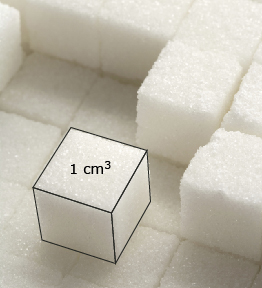Lesson 1
1. Lesson 1
1.6. Explore 2
Module 7: Volume and Capacity
Volume and capacity estimation skills are extremely important in any trade. These skills are used not only to determine which unit to use, but also to provide estimates of a project’s cost.
Method 1: Using Volume and Capacity Referents
Referents are used to form a mental image of common units of volume or capacity. For example, each edge of a sugar cube is approximately 1 cm long; therefore, a sugar cube can be used as a referent for a volume of 1 cm3. When you’re estimating the volume of a larger object, such as a calculator, you can imagine how many sugar cubes it will take to occupy the same space.

iStockphoto/Thinkstock

Try This 2
- Use a tape measure or ruler to measure objects of approximately the same volume as each of the cubic units listed in the chart. (A few examples have been filled in.) Pick objects you are likely to remember. Later, you will use these referents as mental images to estimate volume.
Units of Volume Referent 1 Referent 2 1 cm3 a sugar cube 1 m3 1 in3 1 ft3 1 yd3 a washing machine
- Look around your home or school to find containers (cans, milk jugs, paint cans) that have approximately the same capacity as each of the units in the chart. Later you will use these referents to estimate capacities.
Units of Capacity Referent 1 tbsp (tablespoon) 1 c (cup) 1 pt (pint) 1 qt (quart) a quart of motor oil 1 gal (gallon) 1 L (litre) 1 mL (millilitre)
Share 1
Share your charts from Try This 2 with a classmate or with a group of people. Add any new referents to your charts to help visualize volumes and capacities.